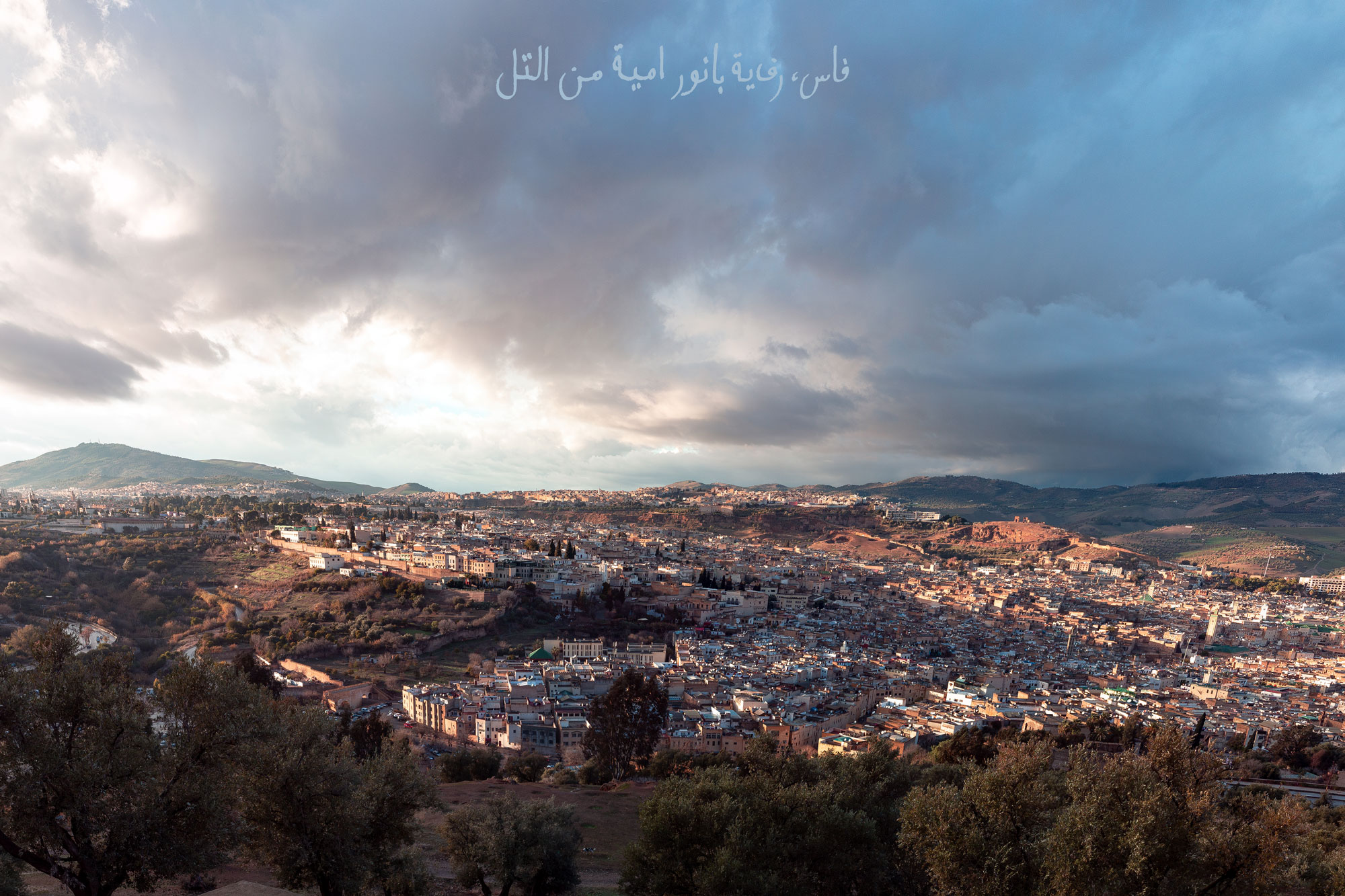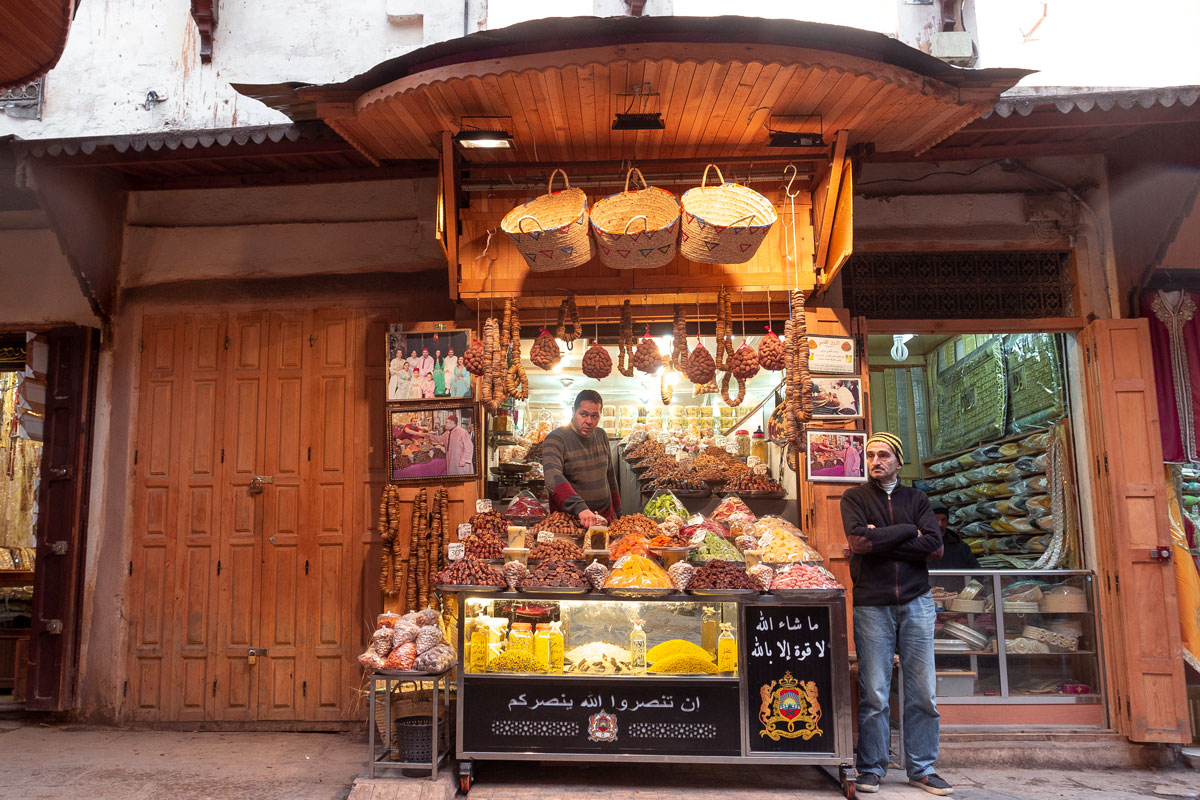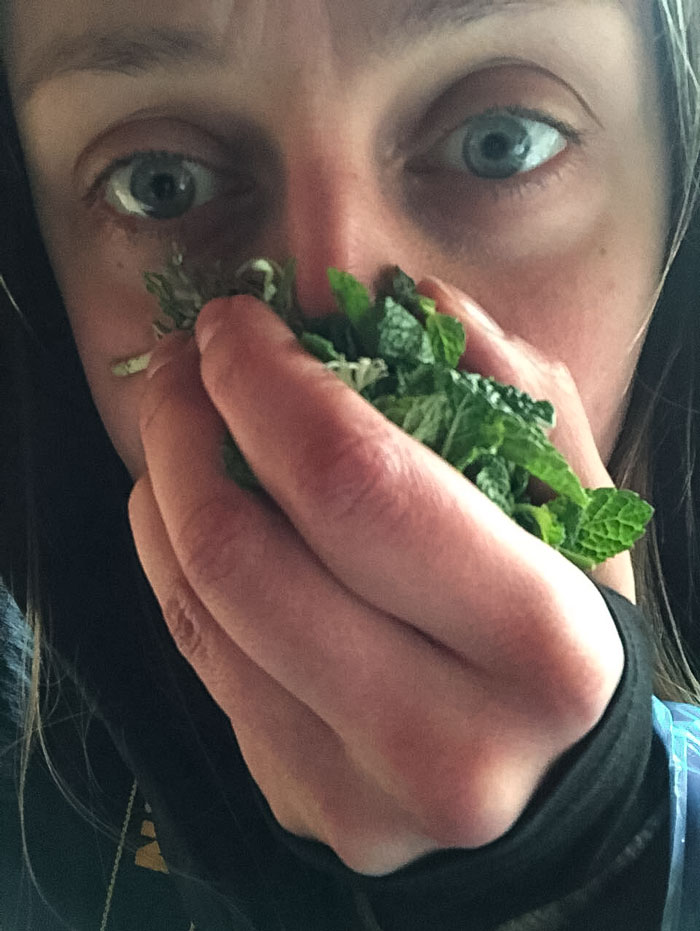Fez
On the outskirts of Fez, we find ourselves in a modern city with business centers, luxury hotels, and tidy sidewalks. But where are the slums?

This is an example of the famous Moroccan dual-city system.
All cities in Morocco are organized according to the same principle. A special zone, located 5 kilometers away from the old medina, is designated for the construction of business districts and modern housing. The historical center, on the other hand, remains untouched. It is preserved in its original state with all the bazaars, smells, and slums.

Fez is the most vivid example of a dual-city. The business districts are very modern and European. There are plenty of expensive restaurants and offices of large companies here. But as soon as you reach the historical part of the city, biblical landscapes begin.

Fez is surrounded by hills with ancient ruins. The city itself hides behind fortress walls. In rainy weather, light breaks through a hole in the sky and shines on the central mosque — that’s how it was designed.

In the city itself, it becomes clear why it hasn’t been demolished yet. Firstly, there is simply no place to build something new in the medina.

The houses in the medina of Fez are so tightly packed that there is no room to install a cellular tower, let alone a new building.

Secondly, if even one house is demolished for construction, the entire Fez will collapse like dominos. Each house in the medina of Fez is interconnected with all the other houses through beams, planks, and joists; glued together and patched with plaster.


The houses in Fez are supported by such a large number of props that sometimes an entire forest grows out of them, blocking all white light.

Along these planks, one can walk across the roofs of the entire Fez and enter each house strictly once. Poor Euler would have been challenged if he had to solve a problem about the houses of Fez instead of the bridges of Königsberg.

A large part of Fez, like Marrakech, is occupied by the market. However, the market in Fez is smaller than the one in Marrakech. The stalls here are densely packed in several areas of the city and then become less frequent. Overall, the market has a different atmosphere.

When I stroll through the eastern bazaars, the same thought always comes to my mind: if the city had five supermarkets, 100% of these stalls and small shops would disappear.

The eastern bazaar is enormous and endless simply because Arabs don’t have warehouses. Goods in supermarkets are stored in packaged form in a warehouse. There, they occupy sometimes 5 or 10 times less space than in the store.

In the Arabic market, all goods are initially unpackaged and piled up in stores, stockrooms, and the homes of local sellers.

Each stall has its own owner-seller. However, so many sellers are simply not necessary. Even in the largest supermarket, there are unlikely to be more than 30 checkout counters. And this supermarket can serve tens or hundreds of times more customers than a multi-thousand army of Arab merchants.

However, it is impossible to build a supermarket in Fez. There is simply no place for it!
But even if a solution is found to this problem and the old medina is equipped with the latest self-service innovations, what will countless vendors do who will lose their jobs?

They will all have to find other jobs.
And if the economy of Morocco were free, this work would most likely be found. There would be demand for cheap websites from France or for phone operators and technical support from the USA. Most likely, over time, the reserve workforce would find new occupations.

But that is unlikely to ever happen. The residents of the medina would shatter any supermarket if an attempt were made to open one. However, it won’t even appear because there is simply no place to put it without collapsing the entire Fez.

This city is not subject to modernization. It will forever remain in the Middle Ages.

Hashish Plaza
Kurakin bursts in:
“Hey, do you have a hundred rubles bill? I made friends with a local, promised to give him some Russian money.”
“Redhead, where did you befriend him? Let’s go together.”
Kurakin takes us to some notorious multi-story bar. It’s amazing how Moroccan cities transform with the arrival of night. It turns out that the place is filled with bars and restaurants, although they are not visible during the day. At night, numerous neon signs light up, revealing that the Muslim city drinks and dances.
All seats are taken in the disreputable bar, but the attendant finds a vacant table for us. We find ourselves on the second floor of one of those dilapidated buildings propped up with supports. The bar is filled with loud music, drowning out our own words. Smoky.
I understand that they smoke hashish here, not cigarettes. The three-story bar is thoroughly permeated with drugs, and no one even feels ashamed. The locals immediately offer us to join them in smoking. We decline.
“I’m thinking, maybe smoke with them?”
“No, I’ll pass. Who knows how it could end. Morocco seems like a friendly country, but only during the day. At night, ghouls come out.”
Kurakin orders more beer and potatoes. A brawl breaks out in the bar. It’s better to leave the three-story hashish plaza. We don’t even know what punishment awaits for indulgence in Morocco.
Let’s return to contemplating African economy.
Five kilometers away from the old city of Fez, a new Fez has been built with casinos and prostitutes. Why wouldn’t the residents of the medina find work there and leave the old town?
The thing is, all these people earn much more from tourists. Every year, 10 million people visit Morocco. They all flock to Marrakech and Fez, buying up everything from the market stalls.
Why hunch your back in an office? Just need to sell a fez or beads to a tourist for five times their actual price.

The most popular way to spend money in Fez is a tour of the tanneries. We paid 100 dirhams for it, which is almost 700 rubles. With such money, you can barely get by for a day even in Russia, while everything in Morocco is much cheaper.
And how many of such tours are conducted in a day? Three, five, ten?
Surely on a good day, there are about ten clients. That would be 7,000 rubles per day. However, they will most likely have to share it with the owner of the tannery and the local gang. Well, tour guides can make a couple of thousand on a lucrative day.
But I wouldn’t envy their job. Tanneries are the most foul-smelling place on Earth. Even the shittiest dumps in India don’t smell as strong as Moroccan tanneries!

Moreover, in the tanneries, they don’t skin animals or gut carcasses. The smell doesn’t come from the leather at all.
The skin, carefully stripped from cows, sheep, and camels with the blessings of Allah, is brought here already prepared and cleaned. In the tanneries, it is only processed and refined.
The entire processing is done by hand. The technology has remained unchanged for many centuries, as well as the equipment. The tannery from above resembles a beehive with honeycombs, except that instead of fragrant honey, the clay combs are filled with foul-smelling mixtures.
First, the skin is passed through white combs filled with a solution of lime and chalk.

After that, the skin is sent for dyeing. On modern factories, aerosols and liquid chemicals of any color obtained through chemical processes are used for dyeing. In Fez tanneries, only natural dyes are used. That’s why they have such an unbearable smell, and the range of colors is limited.

For each color, there is a specific composition of dye. To obtain the color red, poppy and red pepper are mixed. To achieve yellow, the skin is soaked in a mixture of saffron, pomegranate, and mimosa flowers. If green is desired, mint is added. Blue is obtained from indigo crystals, which are also used to produce certain types of ink.
And brown... brown is obtained from chicken droppings.

Can you imagine the smell of this entire mixture? The workers have already gotten used to it, but tourists can easily feel nauseous in the middle of the tour.
To describe this stench more accurately... Imagine a rural outhouse-hole in a wooden cabin with a heart-shaped sign. One that hasn’t been cleaned for several years. In the heat. Picture yourself inhaling deeply before entering this toilet to relieve yourself for just half a minute, and quickly exiting before flies swarm around you.
Can you imagine it? Now, imagine being submerged headfirst into that hole and held there. Feeling nauseated?
That’s why tourists are given a bundle of mint. It should be tightly pressed against the nose, and you should breathe only through it. The guide refers to it as a “gas mask.”

The workers themselves are up to their ears in tanks with excrement.

Ewww.

Uuuugh. Look, there are feathers there. Those are tanks with chicken manure. Uuuugh.

You can’t just walk into the tannery like that. It’s private property. The workers allow themselves to be filmed because it’s a condition set by the factory owner — the tours are as profitable as the leather itself.

Leather production is very well paid. Not everyone is allowed into the tannery — only through family connections or personal favors.

Indeed, such work is very harmful. Breathing in all that excrement is not just disgusting, it also affects one’s health. Intoxication prevents working continuously for more than a couple of months. That’s why people come to the tannery to earn money and then go back home.

After about ten minutes, you get used to the smell. They say it doesn’t smell as strong in winter, but during the hot summer when it’s +40 degrees Celsius, one might even feel like dying. The clothing continues to subtly smell for a few more days after the tour.

It takes about two weeks to dye a single hide. Then the dyed cow transforms into a leather jacket or pants for the “Night Wolves.” In tanneries, future clothing lies in the form of a pile of scraps, waiting for its moment.

An entire block is occupied by tanneries. It’s best to climb onto a neighboring building and look at them from above. Here, the guide will offer to buy something ready-made: a leather jacket or jeans. From the store, there is a beautiful view of the production.

They say even Louis Vuitton purchases leather from Fez.

Night
Fez is a labyrinthine city.
I have been to many cities, and I have a built-in navigator for mazes. But Fez is so convoluted that I got lost in it like a child.
As soon as you stop and open your phone with a map, a crowd of advisors instantly gathers. Escorting tourists to hotels in Fez is a separate form of business. You can wander around the city for hours without knowing how to get out. The most important thing is to return home before dark.
If Marrakech glows a bloody red at night, then Fez shines in shades of orange and gold.

Ugly walls of old mosques undergo a transformation at night. Calligraphy from the Quran begins to glow as if it were coated with phosphorus.

In hot countries, the rhythm of life is shifted towards the night. It’s too hot during the day, so people work from early morning until noon, then rest until the evening, and continue their activities from the evening until late at night.
Therefore, crowds of children pour out onto the streets of Fez at night. They play football on the old streets.
I walk past a group of young Arab football players. Nearby, another group of teenagers surrounds a local man and does something to his hands. I take a closer look. The teenagers have tied his hands with a ribbon, and he is trying to free himself but failing. The children laugh while the man starts to panic.
A local resident approaches me, thinking that I am lost.
“Buddy, let me escort you!”
“Leave me alone,” I answer, tired and sharp.
“Hey, you! You want to fight?”
Never respond to harassers with rudeness, even if you are very tired — they will perceive it as aggression and may engage in a fight.
I move away, quickly set up my tripod, and try to photograph the bustling street that leads somewhere uphill.
Arabs really enjoy standing around the corner, cracking sunflower seeds, drinking tea, or simply observing the street. When you pass by such individuals, it sends shivers down your spine. It feels as if a maniac is lurking around the corner, waiting for their victim. But no, they are just standing there with nothing to do.
Back at the hotel, while reviewing the photos, I notice a ghostly figure in the left corner of the frame — and jump in surprise.



